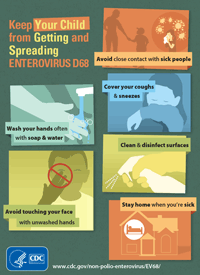Enterovirus D68
Overview
Overall, an estimated 10-15 million enterovirus infections occur in the U.S. each year. Most occur seasonally during the summer and fall. There are over 100 types of enteroviruses; other common enterovirus infections include Hand Foot Mouth disease and viral meningitis.
Enterovirus D68 is one of these types of enterovirus which was first detected in 1962 in California. It is not a new disease, but it is not frequently seen circulating in the community. Outbreaks of enterovirus are similar to outbreaks of other illnesses such as cold and flu, but EV-D68 is less common.
For the latest update on Enterovirus D68 activity nationally, click here.
Who is at risk?
According to the Centers for Disease Control & Prevention (CDC), infants, children, and teenagers are most likely to get infected with enteroviruses and become ill, because they do not yet have immunity (protection) from previous exposures to these viruses. Adults can get infected with enteroviruses, but they are more likely to have no symptoms or mild symptoms. Children with asthma may have a higher risk for severe respiratory illness caused by EV-D68 infection.
Other Frequently Asked Questions
CDC website
Clinicians
Alameda County Public Health Department issued an Enterovirus D68 health advisory on September 30, 2014.
Full ACPHD Health Advisory
CDC Enterovirus D68 Page


